Fiber artist Wendy Ives shares her felting techniques, inspiration and whimsical designs. Enjoy and be sure to visit her website for more.
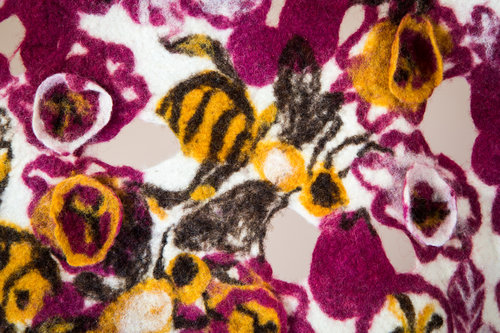
Detail shot, “The Bees Knees” hand dyed felted painting / shawl
My art pieces are constructed with 100% organic wool. I begin each piece by dyeing the wool in small batches, using new, non-toxic plant and insect dye methods. Some of the dyes I make out of compost. A slow, combination of natural chemistry and art is how I achieve one of a kind and repeatable vibrant colors, giving life to each work. I do my best to produce little waste which is suitable for the compost pile.
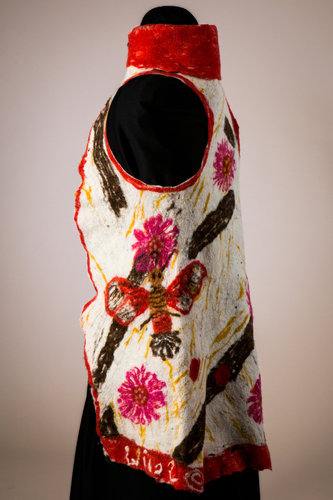
“Hummingbird Moth Shrug” hand dyed felted painting / shawl
After the wool is dyed, I “paint” and hand sculpt to construct the felt fabric. Very thin 100% wool felt with drape, is a technique I’ve been developing over the years. The dichotomy in a delicate looking, or transparent fabric, that is strong and able to be washed in a modern washing machine is a thrill to construct.
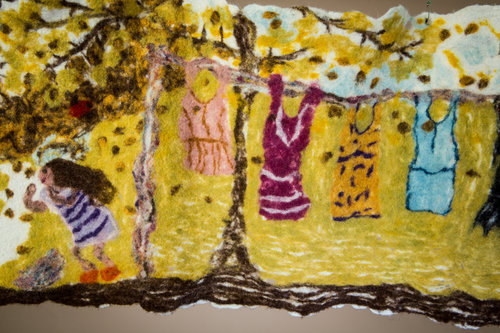
Detail shot, “The Swarm” (AKA The Laundry Line). Hand dyed felted painting / shawl.
When working on a project, I am transported into the message of each piece. My reason for being is to create objects that are pleasing to the eye, while conveying the delicate balance between nature and the human perception of nature as a nuisance. I do not sew, weave, glue, paint, use stencils or drawings as a design layout guide for tracing, or use any pre-made or pre-dyed fabric in this work.
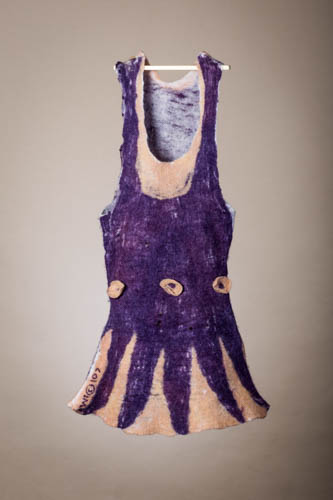
“Purple Flair Drop Waist Dress” 100% organic wool with nontoxic plant dyes. Part of the Swarm (AKA The Laundry Line) installation. Wool Felt, h 16” x w 9” x d 3”
Each piece is intended to bring viewers joy, stimulating an appreciation for the natural world. My materials and subject matter both reflect nature as a renewable resource and a wild world to be left alone, and as something to be taken care of, so the resource isn’t depleted or destroyed. These resources need to be shared by all living things, including humans, animals, plants, and “pests.”
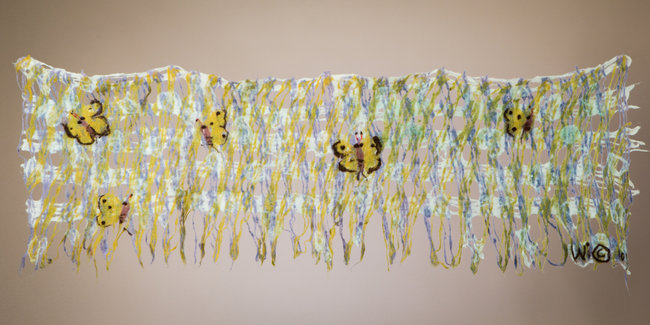
“Little Yellow Butterflies” hand dyed felted painting / shawl. 100% organic wool, with nontoxic plant dyes. Wet felt, w 60” x h 24”
The Shawls
Little Yellow Butterflies: Indigo and fruit dyes mixed together take the viewer to the abstract Queen Anne’s Lace wildflower field on my property, filled with little yellow butterflies, also known as the Common Yellow Butterfly. They feed on abandoned fields and roadside ditches from Costa Rica, through Mexico and Texas, migrating up through, South Dakota, Central Nebraska, and colonizing in the North East.
This pretty little butterfly is abundant and healthy, and very pleasant to watch. They gently fly around wildflowers, and sip at the edge of mud puddles. A sweet sign of summer. This felt lace shawl is thin, transparent and delicate looking like Queen Anne’s Lace flowers. The spaces in the lace construction actually will trap heat providing more warmth that other lace garments.
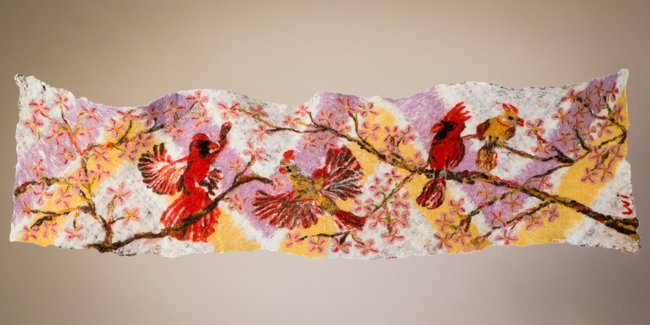
“Cardinals with Apple Blossoms” hand dyed felted painting / shawl. 100% organic wool with nontoxic plant dyes. Wet felt, w 52” x h 14”
Cardinals with Apple Blossoms: Every Spring cardinals eat a nourishing springtime food source of apple blossoms. All birds are singing their spring songs, but it’s those few weeks during the apple tree bloom when the cardinals dine on the blossoms, mate and stand out. Some apple tree owners view the birds as pests, denying them of their seasonal meals and ritual.
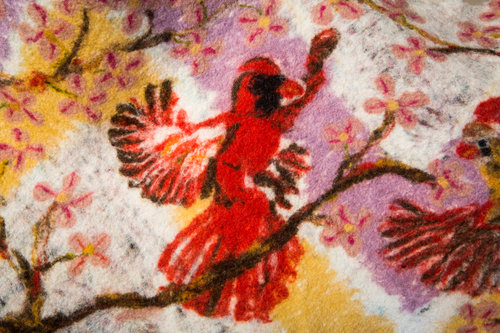
Detail shot, “Cardinals with Apple Blossoms” shawl. Hand dyed, felted.
A close up shows the detail of each feather of the male and the female cardinals in flight as he lands to be near his mate. The apple blossom petal detail, along with the fine drape of the fabric, simulates a spring breeze. The construction of the piece reflects the early spring light in the Northeast US.
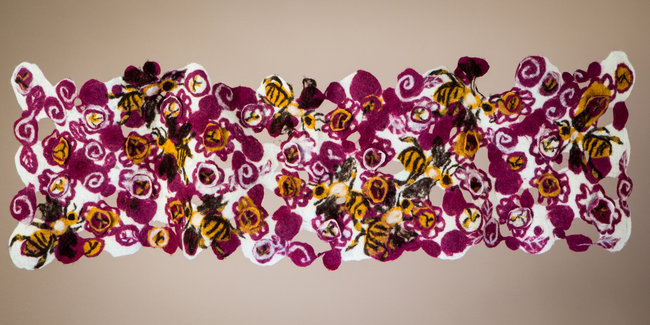
“The Bee’s Knees” 100% organic wool with nontoxic vegetable and insect dyes. Wet Felt, w 52” x h 16”
The Bee’s Knees: This piece is a close up of a primrose garden with bees collecting pollen, with 3D flowers. I chose to put many bees in the primrose patch, so the viewer would look at them as beautiful objects instead of something that was scary or disgusting. Each bee is busy collecting pollen, which is stored in their back leg knee baskets. These are the worker bees, which are the females. Any pollen on the rest of their bodies is deposited on other flowers during their collecting rounds, where a small amount can rub off on the pistil, resulting in cross pollination.
Almost all of the world’s food supply depends on cross-pollination, done by a small variety of pollinators. Our pollinators are at great risk of disappearing because of pollution. The beauty and awe of this piece, in combination with organic fiber and dye, is a message about the pollution on so many levels that harm our pollinators.
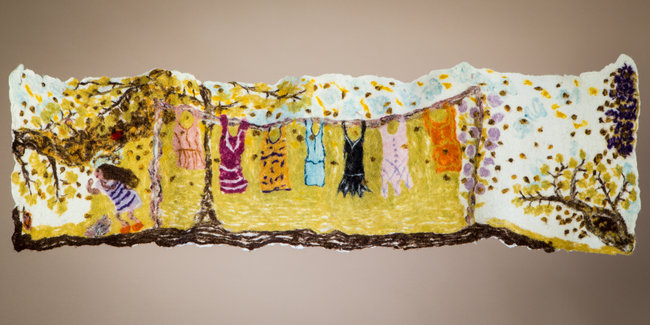
“The Swarm (AKA The Laundry Line”) hand dyed felted painting / shawl. 100% Organic wool with nontoxic plant, fruit and insect dyes. Wet Felt, w 54” x h 14”
The Swarm (AKA The Laundry Line): I was hanging my laundry when a swarm of bees flew over me. This piece depicts my favorite fancy dress laundry load. Bees swarm when the hive splits, since they successfully reproduced and there is a new queen. The new queen and her bees are looking for a new home.
In this case, it was a new hollow tree across the road. You can spot the queen. The scout bees are already at the new tree, while everyone else is getting ready to fly over. They sounded like a jet engine taking off over my head. As you can see, I dropped my basket, since I instinctively ducked, before I realized what I was witnessing.
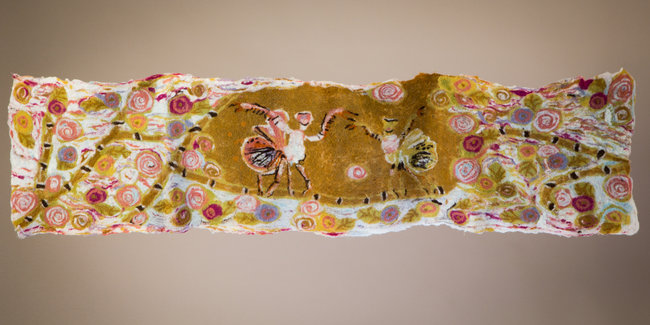
“The Mantises” hand dyed felted painting / shawl. 100% organic wool with nontoxic plant, vegetable, fruit and insect dyes. Wet felt, w 56” x h 16”
The Mantises: Praying mantises are a rare sight in the US. Their ferocious bodies are very beautiful. Their arms and legs are covered with deadly spikes, which grab and slice like tiny knives. Here, they are doing their mating dance in the midst of a flower garden, close up.
The males are hardly ever seen, since soon after they dance and mate, the female bites off his head and eats it! Hence the saying, “I hope he doesn’t loose his head over her.” When you see her, she’s likely already eaten him and pregnant. They eat mites and aphids, which are a great help for gardeners. If worn, the dance is on the wearer’s back. This inspiration came to me when we saw a praying mantis in an organic corn field.


Very nice to see Artsy recognize fiber art! Your work and conscientious methods are refreshing!
Thank you for noticing!
These are very cool!
Your work is awesome and inspiring. I was transported into each piece. Delightful experiece. Thank you!!
Thank you Khalidah.